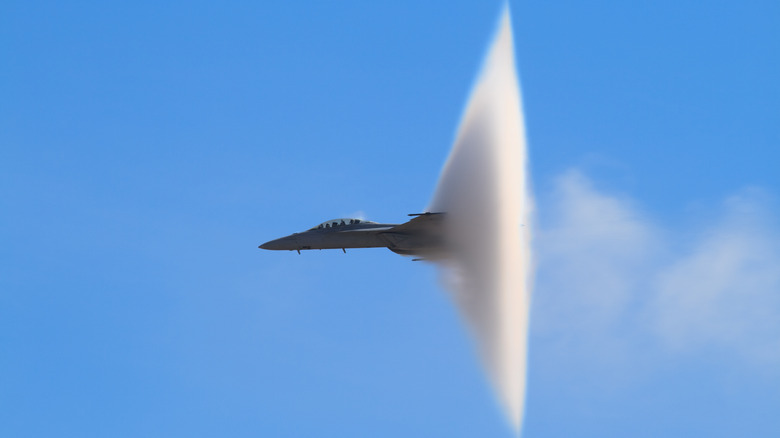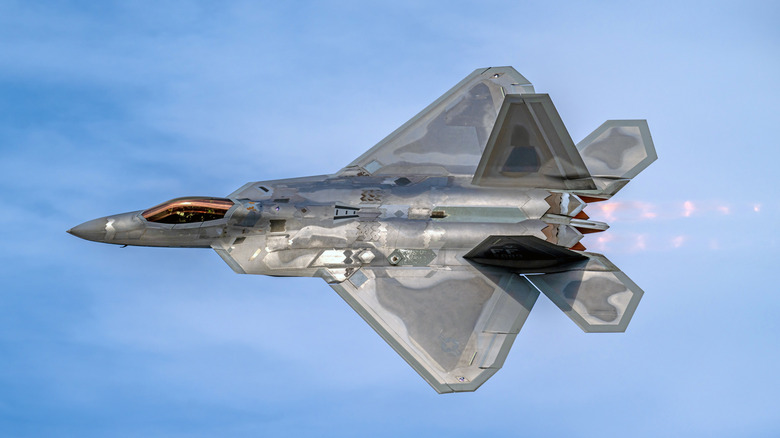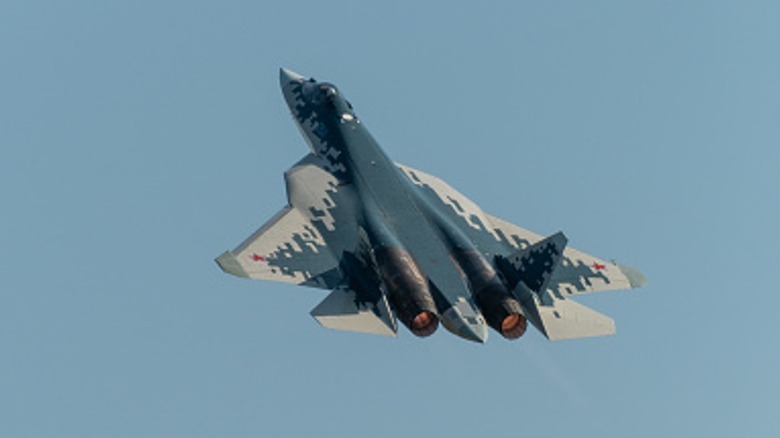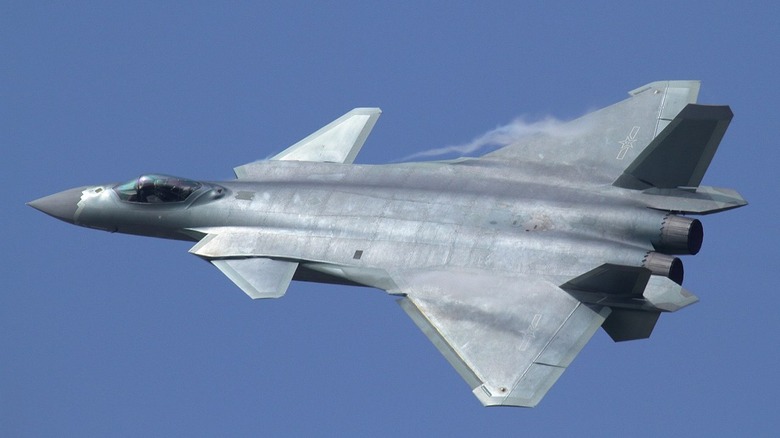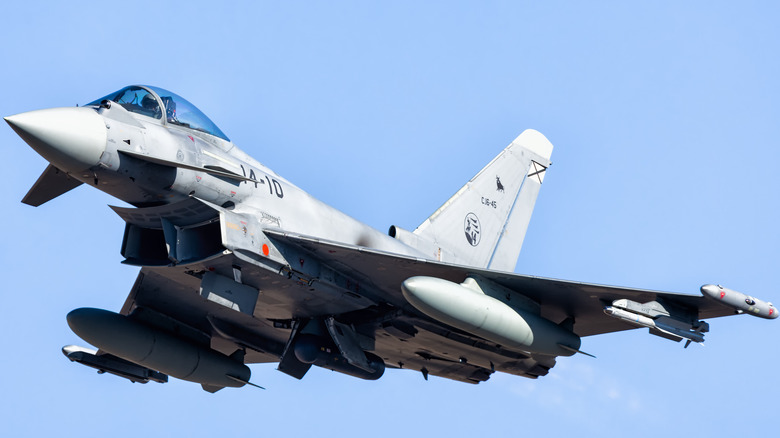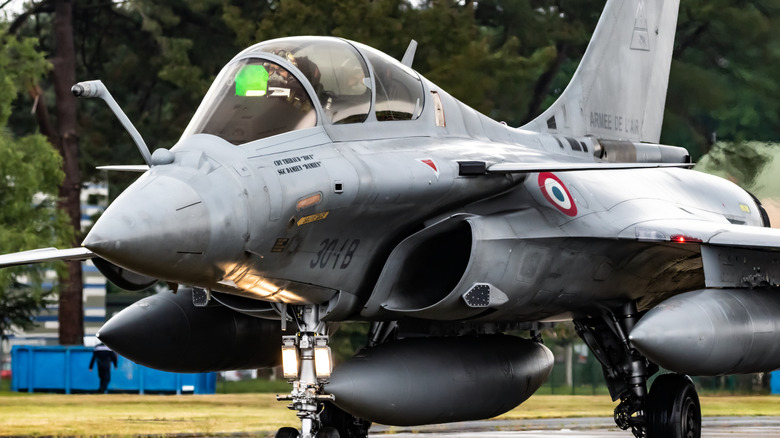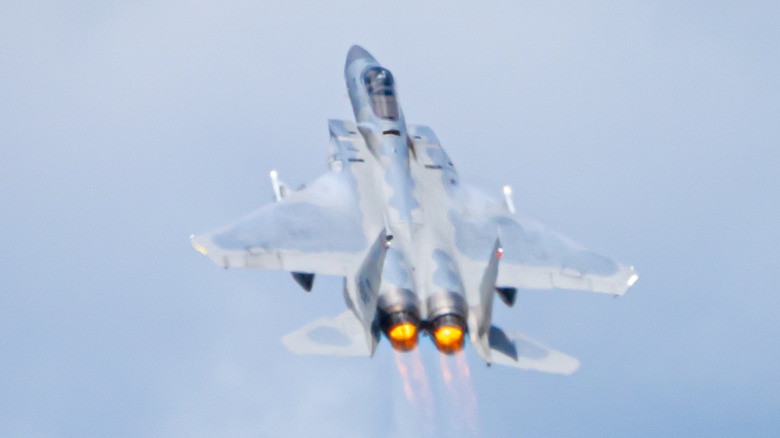Every Jet In Service That Can Supercruise
Even before Chuck Yeager first broke the sound barrier with the Bell X-1 in October 1947, engineers and physicists have played with the amount of thrust planes can generate. The Bell X-1's success gradually led to the F-100D Super Sabre, the first supersonic fighter jet. By the 1970s, every fighter jet in the air could exceed Mach 1. Nowadays some can travel two times faster than the speed of sound, otherwise known at Mach 2, if pilots engage the afterburner.
The fighter jet's afterburner dumps fuel directly into the engine's air intake to generate significantly more thrust. As you might expect, this expends a great deal of fuel. That's why many jet engine manufacturers have been building engines that can travel faster than the speed of sound without needing the afterburner (though this doesn't get the jet up to its maximum speed). This ability is often referred to as supercruise, or simply cruising at supersonic speeds. It not only helps a plane get to its destination quickly without the afterburner, but its biggest benefit is fuel conversation. There aren't many modern fighter jets capable of supercruise, so here's the short list of those now flying that can.
The USAF's F-22 Raptor can cruise at Mach 1.5
Lockheed Martin's F-22 Raptor is the U.S. Air Force's pride and joy when it comes to combat, and rightfully so. The twin Pratt & Whitney F119-PW-100 turbofan engines can get it to travel faster than Mach 2 with the afterburner engaged, allowing it reach its destination in no time at all. However, whenever the pilot wants to conserve fuel and improve the jet's range, it can supercruise faster than Mach 1.5, making the Raptor an exceptionally impressive weapon. With its supercruise ability, it can get to its destination quickly, fly its mission, ensure that its job is complete, tango with enemy fighters if need be, and still have enough fuel to make it back to base.
Yes, the Raptor is getting up there in years, as it has been in service since 2005, but no replacements are being developed at the moment. The Air Force is confident in its capabilities going forward, with Gen. Kenneth S. Wilsbach explaining to The War Zone in July that a number of planned upgrades will keep it in service for many years to come. And the Air Force praised the Raptor in 2022, saying ,"The sophisticated F-22 aerodesign, advanced flight controls, thrust vectoring, and high thrust-to-weight ratio provide the capability to outmaneuver all current and projected aircraft." It's so advanced that America won't risk selling the F-22 to foreign countries, including our closest aillies, which might reveal the secrets to its success.
Russia claims its Su-57 can keep up with the F-22
Russia kept details about the MiG-29 and Su-27 fighter jets' successor under wraps for a good deal of time before it was finally delivered to Russia's Air Force. Understandably so. The Sukhoi Su-57 is Russia's answer to America's F-22 Raptor, except it endured a glacial development phase. Russia got to work on the Su-57 in 2002 and didn't get it into the field until 2020. While it can travel as fast as twice the speed of sound, it's capable of sustaining Mach 1.3 without engaging the afterburners.
The Felon — as NATO has designated it – is equipped with two Saturn/Lyulka 117S turbofan engines, each producing 31,305 pounds of thrust. Coupled with being built out of different composite materials and aluminum load-bearing honeycomb fillers, it's easy for the Su-57 to cruise at supersonic speeds. Felon pilots can take it as far as 2,175 miles without the afterburner before needing to refuel. However, its range is significantly reduced to 932 miles if the pilot uses the afterburner. Besides being tested in Syria during 2018 in combat scenarios and seeing some action during the Russia/Ukraine war, nobody has really had a chance to see exactly what the Su-57 is capable of.
China's J-20 Mighty Dragon is a mystery plane
The Chengdu J-20 Mighty Dragon is China's fifth-generation fighter jet and an attempt to claim air superiority. It entered service for the People's Liberation Army Air Force in March 2017, making China the third nation to wield fifth-gen fighter jets — Russia and the U.S. being the other two. Not only is it faster than the F-35 Lightning II, America's newest fifth-gen fighter, it's also said to have supercruise capabilities, unlike the F-35. However, it's not known how fast it can cruise. In fact, there's not a whole lot we know about China's newest fighter jet as the government keeps its details shrouded in secrecy. It hasn't even entered any combat situations to ascertain a good gauge of its capabilities.
The Mighty Dragon was initially going to use a pair of Russian power plants until China managed to create their own. It has twin Woshan-15 (WS-15) engines, which, Breaking Defense says, have nearly the abilities of the F-22A's F119 engine. It's noted, however, that the WS-15 doesn't have the same endurance as the American-built engines.
Building their own power plants for a prime fighter jet makes China less reliant on other countries if and when it becomes part of a major conflict. Beyond the J-20's supercruise capabilities, China also says it can keep up with anything America and Russia have in their air forces.
[Featured image by Alert5 via Wikimedia Commons | Cropped and scaled | CC BY-SA 4.0]
European countries joined to build the Eurofighter Typhoon
It's not just fifth-generation fighter jets being built with supercruise capabilities. Thanks to an assortment of upgrades, there are some fighter jets that can be considered in a generation of their own, generation 4.5. Eurofighter GmbH of Germany — a consortium of BAE Systems of the United Kingdom, Alenia Aeronautica of Italy, EADS Deutschland (formerly DaimlerChrysler) and EADS Spain — came together to develop the Eurofighter Typhoon, a delta-wing fighter jet that also has a canard, a small wing ahead of the main wings. It took its maiden flight in 2002 and has been in operation for multiple militaries since 2009, starting as an air-to-ground fighter before shifting into a multi-role position.
Eurofighter fit the Typhoon with two Eurojet EJ200 engines that produce 20,232 pounds of thrust each with the afterburners engaged, getting it up to Mach 2 . When the engines are used without the afterburner, they produce 13,488 pounds of thrust each and let the Typhoon cruise faster than Mach 1 when necessary. Germany, the U.K., Italy, Spain, Austria, Saudi Arabia, Oman, Kuwait, and Qatar rely on the Typhoon. It's expected to remain in service until at least 2040.
Europe's other delta-wing fighter jet: the Dassault Rafale
France's multirole fighter jet has a strikingly similar appearance to the Eurofighter Typhoon with its delta-wing-and-canard design, and that's not where the similarities end. Like its Eurofighter counterpart, the Dassault Rafale has received enough modernization for it to also be considered part of the 4.5 generation of fighter jets. Plus, it can maintain a cruising speed faster than Mach 1 thanks to its two Snecma M88 engines. Without the afterburners engaged, each engine produces 11,000 pounds of thrust. However, if the pilot decides to engage them, then each will push out 17,000 pounds of thrust, giving the jet a maximum speed of Mach 1.8.
France's Navy received the fighter jet first, in 2004. The French Air Force wouldn't have the Rafale (literally French for "gust of wind," but meaning a burst of artillery fire) until 2006. It proved itself as a quality fighter enough to pique the interest of other countries, and France has exported the Rafale to Egypt, India, Qatar, Greece, Croatia, the United Arab Emirates, Indonesia, and Serbia. Dassault and France are happy enough with the Rafale that it's expected to be in service well past 2050.
The F-15 is as impressive as ever
An unexpected fighter jet capable of sustaining such speeds without the afterburner is the F-15 Eagle. It's older, but it's had a lot of upgrades since its first delivery to the U.S. Air Force in 1974, keeping it as capable as any fighter jet today. The newer F-15EX Eagle II is essentially a whole new jet. Sure, it looks identical to its predecessor but the avionics, sensors, radar system, and head-up display are all new. It even comes with a helmet-mounted display.
Rob Novotny, retired Air Force brigadier general, career F-15 pilot, and now Boeing's executive director of fighters business development, told The War Zone, "Yes, the F-15EX can supercruise, but this warrants some context. ... Once we start hanging combat-relevant items on, the ability decreases." But even the older F-15C from 1979 could supercruise: Novotny mentions his time in an F-15C when he went supersonic without engaging the afterburner while friends did so in F-15Es equipped with conformal fuel tanks.
The Eagle has always been impressive, even as newer generations emerged. While it can't make vertical takeoffs and landings, it's always been able to initiate a steep climb immediately after takeoff, angling to reach an altitude of 30,000 feet in just one minute. The F-15E was capable of speeds up to Mach 2.5, while the Eagle II can get up to 2,225 mph, just 80 mph shy of Mach 3, outrunning most anything it runs into in the skies above.
